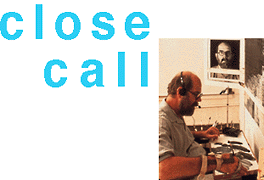

He later moved into painting big heads, but his ideas began to change. At first, he was into objective detailing of his subjects in works that could compete with photographs for reality. Then he moved more into color and added some abstractness to the work, using the face as the frame. No longer did you see perfect "photo-mechanical" representations. " The image had dissolution," he says.
That continued in his work after his disability struck--and he has received even more acclaim.
"It is the opposite of the precision work before his disability," Mason says. "It is a great paradox. From far away the paintings look like passport photos but up close, they turn into this mosaic of dozens of different, individual paintings. How he makes it work is magic."
The magic was evident early on in his life when he picked up a drawing pencil or paintbrush. "I was no good at anything else," Close explains. "I could draw, and having an audience was interesting to me. That felt good."
He took private art lessons, drawing and painting from nude models when he was eight. "I was the envy of my classmates," he says.
That continued when he was an Everett.
"He was a premier student, and distinctive because of his chatter," says Russell Day, who was chairman of the Everett art program. "He was very energetic, a show-off, and very verbal. He was a top student, but back then, in terms of creativity, he didn't show it. He sure does now."
Close went to the UW for the reputation of its art program and because he didn't have any money. In the two years he was there, he shared a house with several other artists, and was known as an energetic, almost possessed painter. He was 6 foot 3 and weighed 210 pounds but hated one flaw: he was bald at 20. "Being bald when you are 20, you're used to never looking the way you want to look, but I thought I had a decent body. I took pleasure in my body," he says.
He also took great pleasure in his work. As a UW student in 1960, he was at a thrift shop near Lake Union when he came across a desecrated U.S. flag. He painted on it, and put on patriotic inscriptions, such as "E Pluribus Unum." The painting drew little reaction while on display at the UW, or even at the Seattle Art Museum as part of the Northwest Annual show. He even won a prize for it. But when it was displayed at the Puyallup Fair, the American Legion objected strenuously. Some legionnaires tried to chop down the door to get at it, and the media coverage was substantial. "It was my 10 little minutes of fame," he says.
On the Edge of Death--and Rebirth
Return to the Beginning of "Close Call"
Return to Finding His Own Voice Through Photorealism
Chuck Close's Gallery and Contact Information
Send a letter to the editor at columns@u.washington.edu.